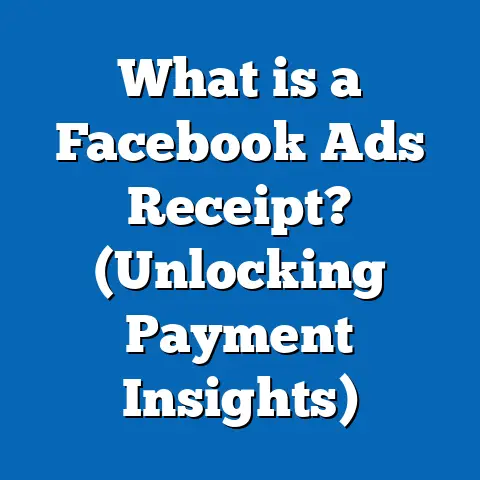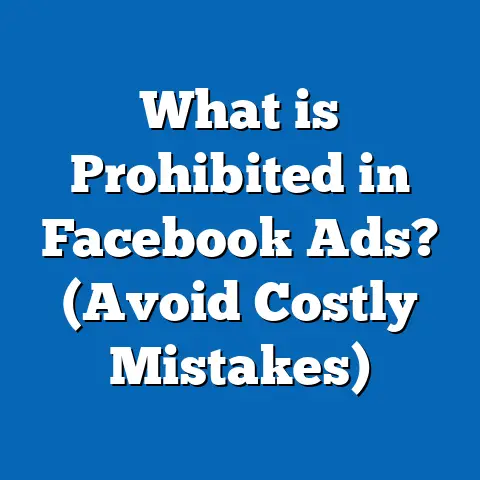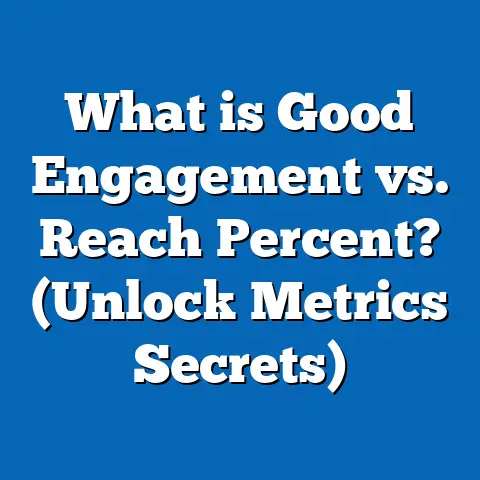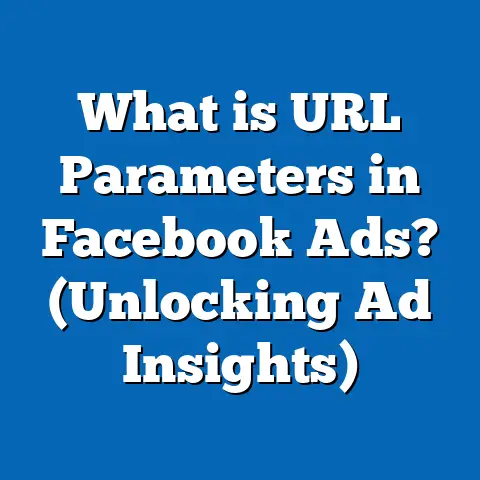What is Domain Tracking in Facebook Ads? (Boost Your ROI!)
Introduction: The Art & Science of Facebook Domain Tracking
Picture a sleek, visually stunning website paired with an equally captivating Facebook ad campaign. The colors pop, the messaging is sharp, and the call-to-action (CTA) is irresistible. Yet, despite all this aesthetic brilliance, you’re left in the dark about what’s driving your results. Are those conversions coming from your latest carousel ad or that eye-catching video? What happens after users click through to your site? Without domain tracking, you’re operating blindfolded—missing out on vital data that could maximize your ad spend and skyrocket your ROI.
In today’s fast-evolving digital landscape, mastering the intricacies of Facebook’s tracking ecosystem isn’t just a technical necessity—it’s a strategic advantage. Properly implemented domain tracking bridges the gap between your creative vision and tangible business outcomes, ensuring every dollar spent delivers measurable value. Let’s dive deep into what domain tracking in Facebook Ads means, why it matters, and how you can leverage it to boost your ROI.
Understanding Domain Tracking in Facebook Ads
What Is Domain Tracking?
Domain tracking in Facebook Ads refers to the process of monitoring and attributing user actions on your website back to specific Facebook campaigns, ad sets, or ads. This involves verifying your website domain with Facebook and implementing tools like the Facebook Pixel or Conversions API to gather and interpret user data.
Key Points:
- It ensures accurate conversion measurement.
- Helps comply with privacy regulations (GDPR, iOS 14+).
- Enables advanced campaign optimization.
Why Is Domain Tracking Crucial for Advertisers?
Without domain tracking, you’re unable to see which ads drive conversions. This makes performance analysis guesswork and hampers budget allocation.
Stat:
According to Meta, advertisers who use Facebook Pixel and verified domains report up to 20% more attributed conversions compared to those without proper tracking.
Evolution Post-iOS 14: The New Reality
The introduction of Apple’s iOS 14 privacy features dramatically changed the digital advertising landscape. Users can now opt out of tracking, severely limiting the data available to advertisers.
Impact:
- Conversion data is restricted.
- Attribution windows are shortened.
- Domain verification is now mandatory for full tracking capability.
Data Point
Meta reported a 15-30% drop in reported conversions for many advertisers post-iOS 14 due to unverified domains and incomplete Pixel setups.
Core Components of Domain Tracking
1. Domain Verification
Definition:
Proving ownership of your website to Facebook by adding a DNS record, uploading an HTML file, or adding a meta tag.
Purpose:
- Ensures only authorized parties can configure events for your domain.
- Required for prioritizing conversion events under Aggregated Event Measurement (AEM).
How-To:
- Go to Business Settings > Brand Safety > Domains.
- Add your domain.
- Follow verification instructions (DNS, HTML file, or meta tag).
Pro Tip:
Use DNS verification for scalability across multiple subdomains.
2. Facebook Pixel
The Pixel is a small piece of code placed on your website that tracks user actions (page views, add-to-cart, purchases).
Benefits:
- Tracks conversions and visitor behavior.
- Enables retargeting and lookalike audience creation.
- Feeds data into Facebook’s optimization algorithms.
Example:
A fashion retailer installs Pixel on its checkout page. With domain tracking, they can see which ad drove a specific purchase—even if it happened days after the ad click.
3. Conversions API (CAPI)
With browser-based tracking restricted by privacy changes (e.g., Safari’s ITP), Conversions API allows server-side event tracking. This ensures more reliable data collection.
Comparison Table:
| Feature | Facebook Pixel | Conversions API |
|---|---|---|
| Tracking Method | Browser-based | Server-to-server |
| Ad Blocker Impact | High | Low |
| Data Loss Risk | Medium/High | Low |
| Privacy Compliance | Good | Excellent |
How Domain Tracking Works: Step-by-Step
Step 1: User Clicks Facebook Ad
When a user clicks your Facebook ad and lands on your site, the Pixel fires and starts collecting data—such as page views or purchases.
Step 2: Event Attribution
Facebook matches these actions back to the original ad using cookies or server-side identifiers via CAPI.
Step 3: Reporting & Optimization
Data is sent back to Ads Manager, populating reports with precise conversion metrics. This enables you to:
- See which ads are driving real results.
- Optimize creative and targeting.
- Allocate budget more effectively.
The Impact on ROI: Real Data & Case Studies
Case Study 1: E-Commerce Brand Post-iOS 14
Scenario:
An online skincare retailer struggled with underreported conversions after iOS 14 updates.
Solution:
- Verified their domain.
- Prioritized key conversion events (Add to Cart, Purchase).
- Integrated Conversions API for server-side tracking.
Results:
- Conversion reporting accuracy improved by 27%.
- ROAS increased from 4.1x to 5.3x within two months.
- Cost per acquisition (CPA) dropped by 18%.
Case Study 2: B2B SaaS Platform
Scenario:
A SaaS provider wanted to measure demo sign-ups originating from Facebook Ads.
Actions:
- Implemented domain verification and Pixel.
- Used UTM parameters for additional attribution.
- Combined CAPI for backend event reporting.
Results:
- Identified that 42% of qualified leads came from retargeting ads.
- Increased retargeting budget by 30%, resulting in a 22% lift in demo requests.
Advanced Insights & Unique Perspectives
Data Loss & Attribution Windows
After iOS 14, Facebook switched from a default 28-day click/1-day view attribution window to a 7-day click/1-day view model. This led to up to 30% fewer reported conversions for some advertisers.
What This Means:
- Shorter attribution means quick conversions are prioritized.
- Longer customer journeys may be under-attributed without proper tracking.
Unique Insight: Multi-Domain Businesses
Businesses with multiple domains (e.g., shop.mysite.com and blog.mysite.com) must verify each domain separately for full event configuration. Failing to do so will create attribution gaps.
Comparing Domain Tracking on Facebook vs. Google Ads
| Feature | Facebook Ads | Google Ads |
|---|---|---|
| Domain Verification Required | Yes | No (uses sitewide tags) |
| Browser Data Dependency | High (Pixel), Low (CAPI) | Medium |
| Post-iOS 14 Adaptation | Mandatory (AEM/Event Prioritization) | Enhanced Conversions API |
| Event Prioritization Needed | Yes | No |
| Reporting Delay | Up to 48 hours | Usually within hours |
Takeaway:
Facebook requires more hands-on setup but offers advanced event configuration to adapt to privacy changes.
Technical Deep Dive: Aggregated Event Measurement (AEM)
What Is AEM?
AEM is Facebook’s solution to ensure privacy while still enabling conversion tracking under new regulations.
How It Works:
- Advertisers can configure up to eight prioritized conversion events per verified domain.
- If multiple events are triggered by a user, only the highest-priority event is reported.
Example:
If a user triggers both “Add To Cart” and “Purchase,” only “Purchase” is reported if it’s set as higher priority.
Limitation:
Only those events that are prioritized will be tracked for users who opt out of tracking on iOS devices.
Practical Implementation Guide
Step-by-Step Setup Checklist
- Verify Your Domain in Business Manager
- Go to Brand Safety > Domains.
- Complete verification via DNS/meta tag/HTML file.
- Install Facebook Pixel on Your Website
- Place code in
<head>section. - Test using Facebook Pixel Helper Chrome extension.
- Place code in
- Configure Conversion Events
- Go to Events Manager.
- Prioritize up to eight conversion events per domain.
- Integrate Conversions API
- Use server-side code or partner integrations (Shopify, WooCommerce).
- Test event match quality.
- Monitor Results
- Regularly check Ads Manager for discrepancies.
- Adjust event priorities as needed based on business goals.
Common Mistakes & Troubleshooting Tips
Mistake #1: Skipping Domain Verification
Without this step, you lose control over event configuration and risk under-reporting conversions.
Mistake #2: Not Using Conversions API
Relying solely on browser-based Pixel means more data loss due to ad blockers and browser restrictions.
Mistake #3: Ignoring Event Prioritization
Non-prioritized events won’t be tracked for opt-out users on iOS devices—meaning lost conversion data.
Actionable Strategies for Boosting ROI
Leverage Event Prioritization
Focus on high-value actions such as purchases or lead submissions when setting up your eight prioritized events.
Combine Pixel + CAPI for Resilient Tracking
Implement both browser- and server-side tracking to capture the most complete dataset possible.
Use UTM Parameters for Cross-Platform Attribution
Add UTM codes to all outbound links in Facebook Ads for backup attribution in tools like Google Analytics.
Regularly Audit Your Setup
Schedule monthly audits of your domain verification status, Pixel firing accuracy, and CAPI integration health.
Latest Trends & Industry Updates
AI-Powered Attribution Models
Meta is rolling out machine learning-powered attribution adjustments to compensate for missing data due to privacy changes.
Stat:
Meta estimates that AI-based attribution can recover up to 65% of previously lost conversion signals.
Enhanced Partner Integrations
Platforms like Shopify, WooCommerce, and Zapier now offer seamless CAPI integration—reducing setup time by up to 50%.
Frequently Asked Questions (FAQs)
Q: Do I need domain tracking if I only run awareness campaigns?
A: Yes—tracking helps measure post-engagement actions even for awareness objectives, allowing progressive funnel optimization.
Q: What if I run ads to several domains?
A: Each must be verified individually in Business Manager for full event configuration control.
Q: Is CAPI required for small businesses?
A: Strongly recommended—even small budgets benefit from resilient event reporting, especially as privacy restrictions increase.
Key Takeaways & Next Steps
- Domain tracking in Facebook Ads is essential for accurate attribution, compliance, and optimization.
- Verify every domain you advertise on and prioritize your most important conversion events.
- Combine Facebook Pixel with Conversions API for robust data collection.
- Stay updated with industry trends as privacy regulations evolve.
Next Steps:
- Audit your current Facebook tracking setup.
- Verify all relevant domains in Business Manager.
- Implement both Pixel and CAPI.
- Regularly review reports and optimize based on new insights.
Final Thoughts
Mastering domain tracking on Facebook isn’t just a technical detail—it’s foundational for maximizing campaign impact and ROI. By combining aesthetics with analytics, you ensure every creative decision delivers real business value. Stay proactive, keep learning, and let robust tracking power your next advertising breakthrough.






